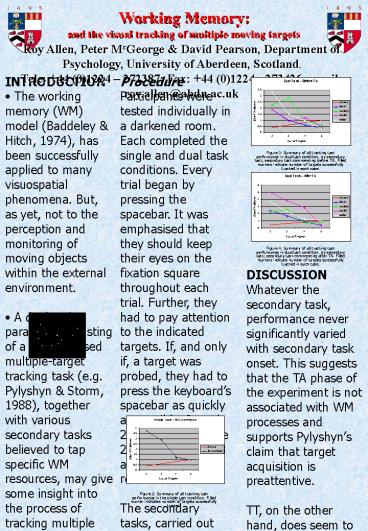Multiple Target Tracking: Does practice make perfect PowerPoint PPT Presentation
1 / 1
Title: Multiple Target Tracking: Does practice make perfect
1
Working Memory and the visual tracking of
multiple moving targets
Roy Allen, Peter McGeorge David Pearson,
Department of Psychology, University of Aberdeen,
Scotland. Tele 44 (0)1224 272387 Fax 44
(0)1224 - 273426 email roy.allen_at_abdn.ac.uk
- INTRODUCTION
- The working memory (WM) model (Baddeley Hitch,
1974), has been successfully applied to many
visuospatial phenomena. But, as yet, not to the
perception and monitoring of moving objects
within the external environment. - A dual-task paradigm consisting of a
computerised multiple-target tracking task (e.g.
Pylyshyn Storm, 1988), together with various
secondary tasks believed to tap specific WM
resources, may give some insight into the process
of tracking multiple moving targets. - METHOD
- Subjects
- 144 post- and undergraduate students, 73F and 71M
took part, aged between 16 and 47 (mean 21.37, SD
4.7). All had normal or corrected-to-normal
vision. Each was paid a small honorarium.
Participants were allocated to one of four
secondary task conditions visual, auditory,
spatial or verbal. For half, these began before
target acquisition the remainder after. - Materials
- Six blocks, each of 40 trials, were prepared in
advance. Each trial began with a centralised
solid white fixation square on a black
background. After a delay, ten static crosses ()
appeared, distributed randomly (see fig. 1). A
number of these, designated as targets (1-5),
were flashed on and off several times the target
acquisition phase (TA), the remainder were
distractors.
- Procedure
- Participants were tested individually in a
darkened room. Each completed the single and dual
task conditions. Every trial began by pressing
the spacebar. It was emphasised that they should
keep their eyes on the fixation square throughout
each trial. Further, they had to pay attention to
the indicated targets. If, and only if, a target
was probed, they had to press the keyboards
spacebar as quickly as possible. It took 2 hours
to complete 200 trials. Accuracy and RTs were
recorded. - The secondary tasks, carried out during each dual
task trial, were labelled - Visual - categorizing single digits, flashed at
1/sec in the fixation square, as high (6-9) or
low (1-4) - Auditory - categorizing tones, played at 1/sec,
as high or low - Spatial tapping the four corner buttons of a 3
x 3 matrix once/sec - Verbal repeating the once/sec.
- RESULTS
- The number of targets that participants could
successfully track was obtained by subtracting
the number of false alarms (FA)from the number of
hits (as per the high-threshold model of signal
detection, e.g. Snodgrass Corwin, 1988). This
figure was then compared to the number of misses,
using binomial tests. - Results suggest that, in the single task,
participants can always track 4 targets
significantly better than chance, p lt 0.05 (see
Fig. 2). During the dual task, for the Visual and
Auditory conditions, participants can always
track 3 targets significantly better than chance,
p lt 0.01 (see Fig. 3), whilst for the Spatial and
Verbal conditions, participants can still track 4
targets significantly better than chance, p lt
0.05 (see Fig. 4). - Analysis of secondary task data confirmed that
participants always allocated adequate and
sufficient resources, always performing above 85
accuracy. - Other analyses on RTs, response bias and
detection sensitivity were carried out but are
not reported here.
Figure 3 Summary of all tracking task
performance in dual task condition, by secondary
task secondary task commencing before TA. Filled
markers indicate number of targets successfully
tracked in each case.
Figure 4 Summary of all tracking task
performance in dual task condition, by secondary
task secondary task commencing after TA. Filled
markers indicate number of targets successfully
tracked in each case.
DISCUSSION Whatever the secondary task,
performance never significantly varied with
secondary task onset. This suggests that the TA
phase of the experiment is not associated with WM
processes and supports Pylyshyns claim that
target acquisition is preattentive. TT, on the
other hand, does seem to utilise WM. Tracking
performance in the Visual condition suggested a
role for central executive resources, an idea
proposed by Yantis (1992), but decrements might
also be due to primary and secondary tasks
sharing the same modality. Tracking performance
in the Auditory condition, though, refuted this
latter interpretation. However, the tracking
performance decrement might just be the effect of
performing any two tasks simultaneously.
Tracking performance in the Verbal condition did
not support this notion. Finally, a tracking task
might seem to be very spatial in nature, however
tracking performance in the Spatial condition did
not support this either. An interpretation is,
therefore, that the central executive plays a
role in the tracking of multiple moving objects.
However, a similar pattern might be obtained
independently of central executive input if, in
fact, visual indexes were amodal. REFERENCES Badd
eley, A.D. Hitch, G.J. (1974). Working Memory.
In G.A. Bower (Ed.), Recent advances in learning
and motivation, Vol. VIII. (47-90) New York
Academic Press. Pylyshyn, Z.W. Storm, R.W.
(1988). Tracking multiple independent targets
Evidence for a parallel tracking mechanism.
Spatial Vision, 3 (3), 179-197. Snodgrass, J.G.
Corwin, J. (1988). Pragmatics of measuring
recognition memory - applications to dementia and
amnesia. Journal of Experimental
Psychology-General 117(1) 34-50. Yantis, S.
(1992). Multi-element visual tracking Attention
and perceptual organization. Cognitive
Psychology, 24 (3), 295-340.
Figure 2 Summary of all tracking task
performance in the single task condition. Filled
marker indicates number of targets successfully
tracked

